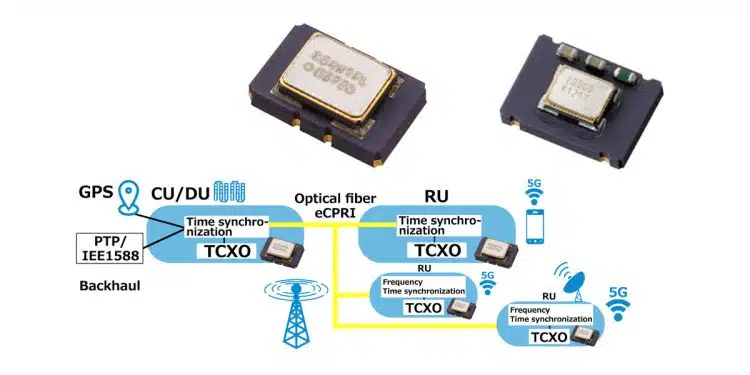5G base stations require components that enable high-speed and high-capacity communications. In this article Kyocera explains how High-Precision TCXOs (Temperature-Compensated Crystal Oscillators) meet demand from 5G base stations with more stable frequency-temperature characteristics than conventional products.
Development Background
5G communications, featuring high-speed, high-capacity, ultra-low latency, and multiple connections at the same time, is now entering its full-fledged introduction phase as IoT technology advances.
Among these, 5G base stations are being installed ahead of others. Demand for miniaturization of 5G base stations has been increasing year by year, and crystal oscillators, which are responsible for communication quality, are also required to be miniaturized and highly accurate.
Against this backdrop, Kyocera has developed a High-Precision TCXOs (Temperature-Compensated Crystal Oscillator) that further improves the characteristics of TCXO, which holds the top share* in devices used in mobile communications terminals. It is currently being mass-produced for 5G base stations.
* Estimates by Kyocera based on market research reports
TCXO Features
High-Precision TCXOs has stabilized the frequency stability to about 1/10 of that of TCXO, which is commonly used in smartphones.
We have also been able to supply products with extremely high temperature characteristics by using low-dispersion crystal unit, which we have cultivated through the development of compact crystal unit.
Kyocera’s High-Precision TCXOs are currently used in 5G base stations as a reference clock to achieve low-latency communication.

As the internal temperature of the set increases due to the internal heat generation of the IC used and the compact and sealed structure, a value of ± 0.1 ppm has been achieved with + 105°C operation, which has been difficult with OCXO (Constant Temperature Chamber Controlled Oscillator).
- Standard frequency [MHz]: 10, 19.2, 20, 24.576, 26, 30.72, 38.88, 40
- Dimensions: 5.0 x 3.2mm, 7.0 x 5.0mm
- Frequency temperature characteristic: ±0.1ppm or ±0.28ppm / -40 to +105°C
Applications
- 5G base stations, RF for networks, Wire communication infrastructure
- Reference clock for high-precision measuring instrument
5G Base Station Example
High-Precision TCXO is used as a reference clock to achieve the low-latency communication required by 5G.

































